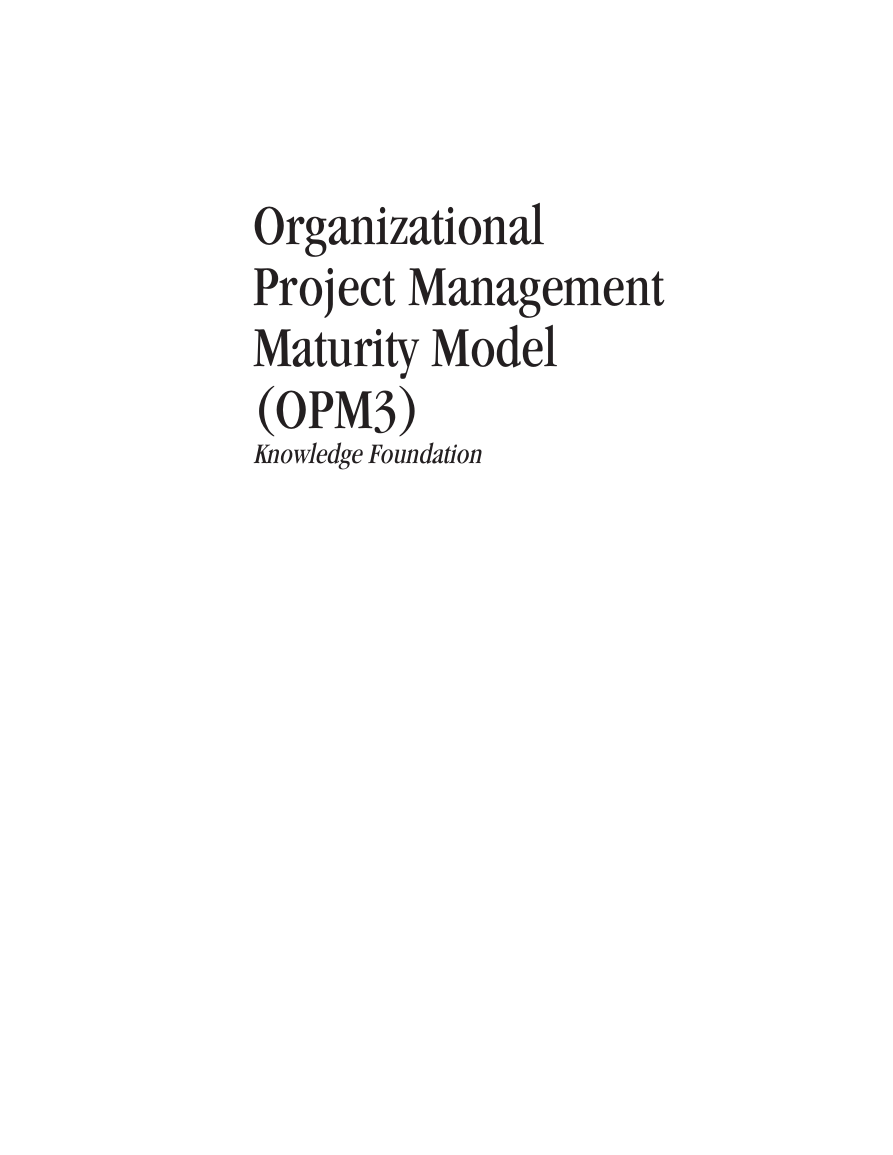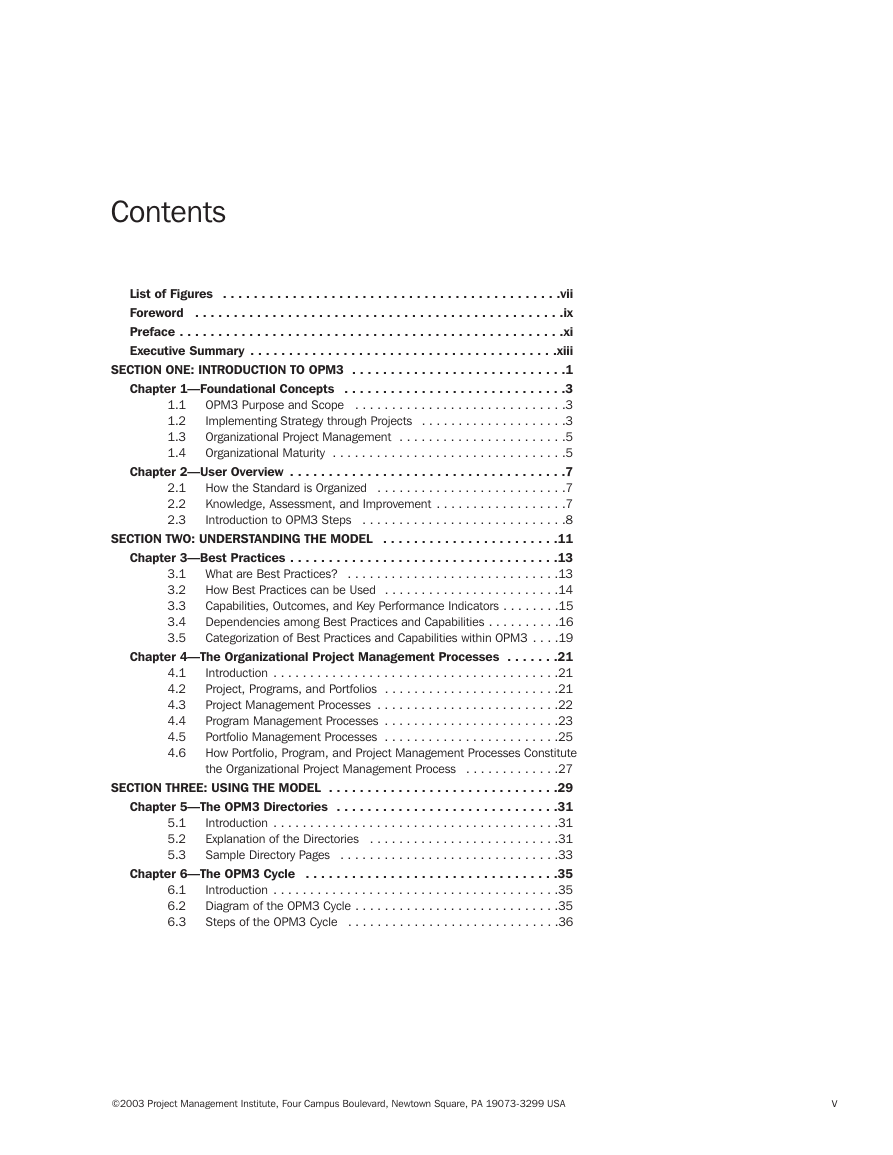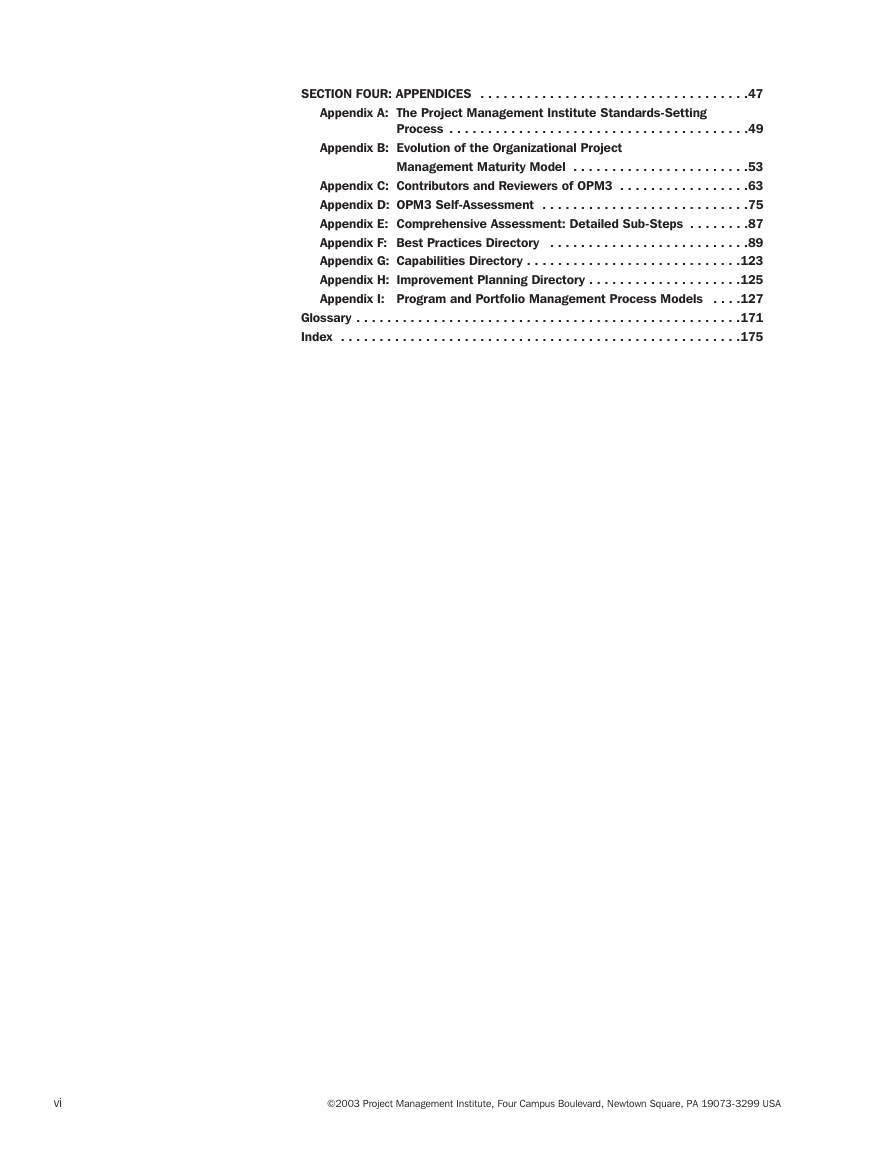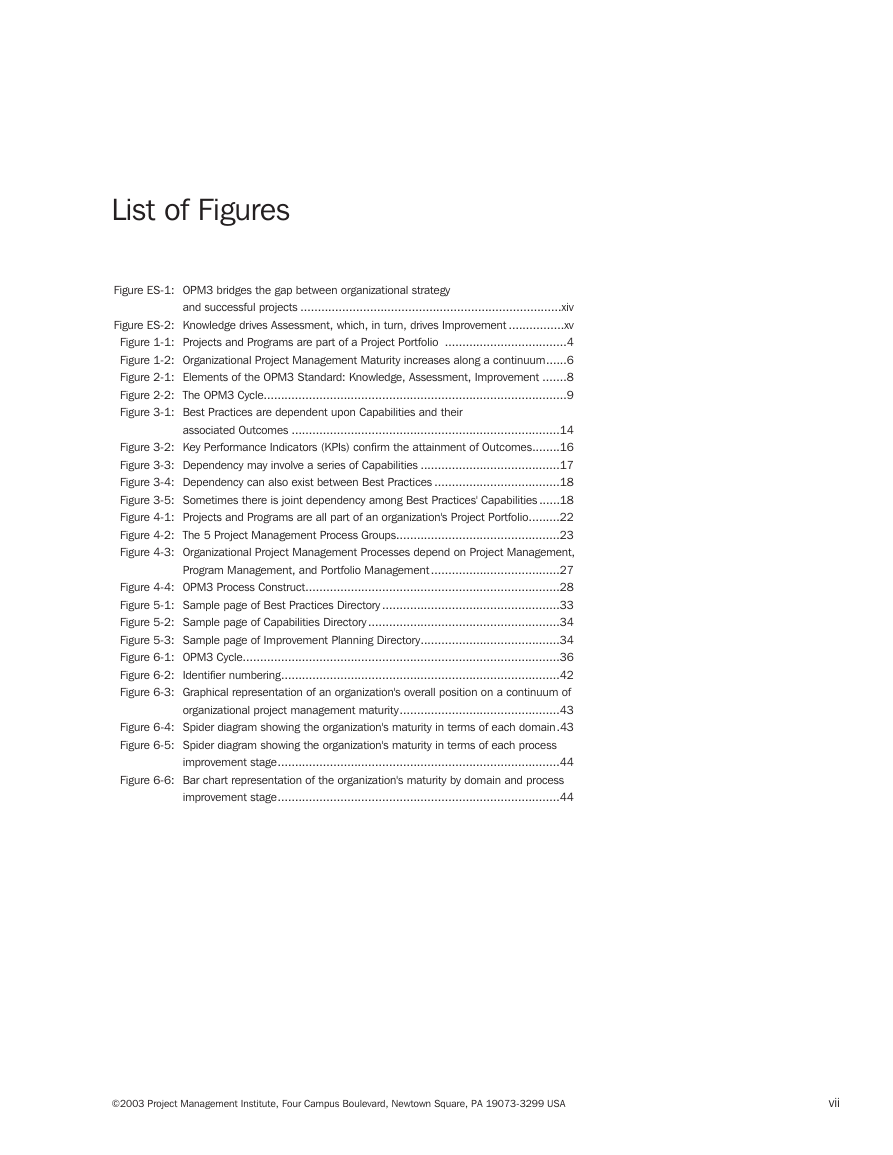Organizational
Project Management
Maturity Model
(OPM3)
Knowledge Foundation
�
�
Organizational
Project Management
Maturity Model
(OPM3)
Knowledge Foundation
Project Management Institute, Inc.
Newtown Square, Pennsylvania USA
�
Library of Congress Cataloging-in-Publication Data
Project Management Institute.
Organizational project management maturity model (OPM3).
p.
cm.
Includes index.
ISBN 1-930699-40-9 (pbk. : alk. paper)
1. Project management—Standards. 2. Project management—Mathematical models. I.
Title.
HD69.P75P76164 2003
658.4’04—dc22
2003064795
ISBN: 1-930699-04-2 (Overview)
ISBN: 1-930699-08-5 (Knowledge Foundation)
ISBN: 1-930699-43-3 (The Standard-Single User Version)
ISBN: 1-930699-07-7 (The Standard-Network Version)
Published by: Project Management Institute, Inc.
Four Campus Boulevard
Newtown Square, Pennsylvania 19073-3299 USA
Phone: 610-356-4600 or Visit our website: www.pmi.org
E-mail: pmihq@pmi.org
© 2003 Project Management Institute, Inc. All rights reserved.
“PMI”, the PMI logo and “PMBOK” are marks of the Project Management Institute, Inc.; “PMP” is a certification mark of the
Project Management Institute, Inc.
PMI® books are available at special quantity discounts to use as premiums and sales promotions, or for use in corporate
training programs as well as other educational programs. For more information, please write to the PMI Publishing,
Bookstore Administrator, Four Campus Boulevard, Newtown Square, PA 19073-3299 USA, or e-mail booksonline@pmi.org.
Or contact your local bookstore.
Printed in the United States of America. No part of this work may be reproduced or transmitted in any form or by any
means, electronic, manual, photocopying, recording, or by any information storage and retrieval system, without prior
written permission of the publisher.
The paper used in this book complies with the Permanent Paper Standard issued by the National Information Standards
Organization (Z39.48—1984).
1 0
9
8
7
6
5
4
3
2
�
Contents
List of Figures . . . . . . . . . . . . . . . . . . . . . . . . . . . . . . . . . . . . . . . . . . . .vii
Foreword . . . . . . . . . . . . . . . . . . . . . . . . . . . . . . . . . . . . . . . . . . . . . . . .ix
Preface . . . . . . . . . . . . . . . . . . . . . . . . . . . . . . . . . . . . . . . . . . . . . . . . . .xi
Executive Summary . . . . . . . . . . . . . . . . . . . . . . . . . . . . . . . . . . . . . . . .xiii
SECTION ONE: INTRODUCTION TO OPM3 . . . . . . . . . . . . . . . . . . . . . . . . . . . .1
Chapter 1—Foundational Concepts . . . . . . . . . . . . . . . . . . . . . . . . . . . . .3
OPM3 Purpose and Scope . . . . . . . . . . . . . . . . . . . . . . . . . . . . .3
Implementing Strategy through Projects . . . . . . . . . . . . . . . . . . . .3
Organizational Project Management . . . . . . . . . . . . . . . . . . . . . . .5
Organizational Maturity . . . . . . . . . . . . . . . . . . . . . . . . . . . . . . . .5
Chapter 2—User Overview . . . . . . . . . . . . . . . . . . . . . . . . . . . . . . . . . . . .7
How the Standard is Organized . . . . . . . . . . . . . . . . . . . . . . . . . .7
Knowledge, Assessment, and Improvement . . . . . . . . . . . . . . . . . .7
Introduction to OPM3 Steps . . . . . . . . . . . . . . . . . . . . . . . . . . . .8
SECTION TWO: UNDERSTANDING THE MODEL . . . . . . . . . . . . . . . . . . . . . . .11
Chapter 3—Best Practices . . . . . . . . . . . . . . . . . . . . . . . . . . . . . . . . . . .13
3.1 What are Best Practices? . . . . . . . . . . . . . . . . . . . . . . . . . . . . .13
How Best Practices can be Used . . . . . . . . . . . . . . . . . . . . . . . .14
3.2
Capabilities, Outcomes, and Key Performance Indicators . . . . . . . .15
3.3
3.4
Dependencies among Best Practices and Capabilities . . . . . . . . . .16
Categorization of Best Practices and Capabilities within OPM3 . . . .19
3.5
Chapter 4—The Organizational Project Management Processes . . . . . . .21
Introduction . . . . . . . . . . . . . . . . . . . . . . . . . . . . . . . . . . . . . . .21
Project, Programs, and Portfolios . . . . . . . . . . . . . . . . . . . . . . . .21
Project Management Processes . . . . . . . . . . . . . . . . . . . . . . . . .22
Program Management Processes . . . . . . . . . . . . . . . . . . . . . . . .23
Portfolio Management Processes . . . . . . . . . . . . . . . . . . . . . . . .25
How Portfolio, Program, and Project Management Processes Constitute
the Organizational Project Management Process . . . . . . . . . . . . .27
SECTION THREE: USING THE MODEL . . . . . . . . . . . . . . . . . . . . . . . . . . . . . .29
Chapter 5—The OPM3 Directories . . . . . . . . . . . . . . . . . . . . . . . . . . . . .31
Introduction . . . . . . . . . . . . . . . . . . . . . . . . . . . . . . . . . . . . . . .31
Explanation of the Directories . . . . . . . . . . . . . . . . . . . . . . . . . .31
Sample Directory Pages . . . . . . . . . . . . . . . . . . . . . . . . . . . . . .33
Chapter 6—The OPM3 Cycle . . . . . . . . . . . . . . . . . . . . . . . . . . . . . . . . .35
Introduction . . . . . . . . . . . . . . . . . . . . . . . . . . . . . . . . . . . . . . .35
Diagram of the OPM3 Cycle . . . . . . . . . . . . . . . . . . . . . . . . . . . .35
Steps of the OPM3 Cycle . . . . . . . . . . . . . . . . . . . . . . . . . . . . .36
4.1
4.2
4.3
4.4
4.5
4.6
6.1
6.2
6.3
1.1
1.2
1.3
1.4
2.1
2.2
2.3
5.1
5.2
5.3
©2003 Project Management Institute, Four Campus Boulevard, Newtown Square, PA 19073-3299 USA
v
�
SECTION FOUR: APPENDICES . . . . . . . . . . . . . . . . . . . . . . . . . . . . . . . . . . .47
Appendix A: The Project Management Institute Standards-Setting
Process . . . . . . . . . . . . . . . . . . . . . . . . . . . . . . . . . . . . . . .49
Appendix B: Evolution of the Organizational Project
Management Maturity Model . . . . . . . . . . . . . . . . . . . . . . .53
Appendix C: Contributors and Reviewers of OPM3 . . . . . . . . . . . . . . . . .63
Appendix D: OPM3 Self-Assessment . . . . . . . . . . . . . . . . . . . . . . . . . . .75
Appendix E: Comprehensive Assessment: Detailed Sub-Steps . . . . . . . .87
Appendix F: Best Practices Directory . . . . . . . . . . . . . . . . . . . . . . . . . .89
Appendix G: Capabilities Directory . . . . . . . . . . . . . . . . . . . . . . . . . . . .123
Appendix H: Improvement Planning Directory . . . . . . . . . . . . . . . . . . . .125
Appendix I: Program and Portfolio Management Process Models . . . .127
Glossary . . . . . . . . . . . . . . . . . . . . . . . . . . . . . . . . . . . . . . . . . . . . . . . . . .171
Index . . . . . . . . . . . . . . . . . . . . . . . . . . . . . . . . . . . . . . . . . . . . . . . . . . . .175
vi
©2003 Project Management Institute, Four Campus Boulevard, Newtown Square, PA 19073-3299 USA
�
List of Figures
Figure ES-1: OPM3 bridges the gap between organizational strategy
and successful projects ...........................................................................xiv
Figure ES-2: Knowledge drives Assessment, which, in turn, drives Improvement ................xv
Figure 1-1: Projects and Programs are part of a Project Portfolio ...................................4
Figure 1-2: Organizational Project Management Maturity increases along a continuum......6
Figure 2-1: Elements of the OPM3 Standard: Knowledge, Assessment, Improvement .......8
Figure 2-2: The OPM3 Cycle.......................................................................................9
Figure 3-1: Best Practices are dependent upon Capabilities and their
associated Outcomes .............................................................................14
Figure 3-2: Key Performance Indicators (KPIs) confirm the attainment of Outcomes........16
Figure 3-3: Dependency may involve a series of Capabilities ........................................17
Figure 3-4: Dependency can also exist between Best Practices ....................................18
Figure 3-5: Sometimes there is joint dependency among Best Practices' Capabilities ......18
Figure 4-1: Projects and Programs are all part of an organization's Project Portfolio.........22
Figure 4-2: The 5 Project Management Process Groups...............................................23
Figure 4-3: Organizational Project Management Processes depend on Project Management,
Program Management, and Portfolio Management .....................................27
Figure 4-4: OPM3 Process Construct.........................................................................28
Figure 5-1: Sample page of Best Practices Directory ...................................................33
Figure 5-2: Sample page of Capabilities Directory .......................................................34
Figure 5-3: Sample page of Improvement Planning Directory........................................34
Figure 6-1: OPM3 Cycle...........................................................................................36
Figure 6-2: Identifier numbering................................................................................42
Figure 6-3: Graphical representation of an organization's overall position on a continuum of
organizational project management maturity..............................................43
Figure 6-4: Spider diagram showing the organization's maturity in terms of each domain.43
Figure 6-5: Spider diagram showing the organization's maturity in terms of each process
improvement stage.................................................................................44
Figure 6-6: Bar chart representation of the organization's maturity by domain and process
improvement stage.................................................................................44
©2003 Project Management Institute, Four Campus Boulevard, Newtown Square, PA 19073-3299 USA
vii
�
�
















 2023年江西萍乡中考道德与法治真题及答案.doc
2023年江西萍乡中考道德与法治真题及答案.doc 2012年重庆南川中考生物真题及答案.doc
2012年重庆南川中考生物真题及答案.doc 2013年江西师范大学地理学综合及文艺理论基础考研真题.doc
2013年江西师范大学地理学综合及文艺理论基础考研真题.doc 2020年四川甘孜小升初语文真题及答案I卷.doc
2020年四川甘孜小升初语文真题及答案I卷.doc 2020年注册岩土工程师专业基础考试真题及答案.doc
2020年注册岩土工程师专业基础考试真题及答案.doc 2023-2024学年福建省厦门市九年级上学期数学月考试题及答案.doc
2023-2024学年福建省厦门市九年级上学期数学月考试题及答案.doc 2021-2022学年辽宁省沈阳市大东区九年级上学期语文期末试题及答案.doc
2021-2022学年辽宁省沈阳市大东区九年级上学期语文期末试题及答案.doc 2022-2023学年北京东城区初三第一学期物理期末试卷及答案.doc
2022-2023学年北京东城区初三第一学期物理期末试卷及答案.doc 2018上半年江西教师资格初中地理学科知识与教学能力真题及答案.doc
2018上半年江西教师资格初中地理学科知识与教学能力真题及答案.doc 2012年河北国家公务员申论考试真题及答案-省级.doc
2012年河北国家公务员申论考试真题及答案-省级.doc 2020-2021学年江苏省扬州市江都区邵樊片九年级上学期数学第一次质量检测试题及答案.doc
2020-2021学年江苏省扬州市江都区邵樊片九年级上学期数学第一次质量检测试题及答案.doc 2022下半年黑龙江教师资格证中学综合素质真题及答案.doc
2022下半年黑龙江教师资格证中学综合素质真题及答案.doc